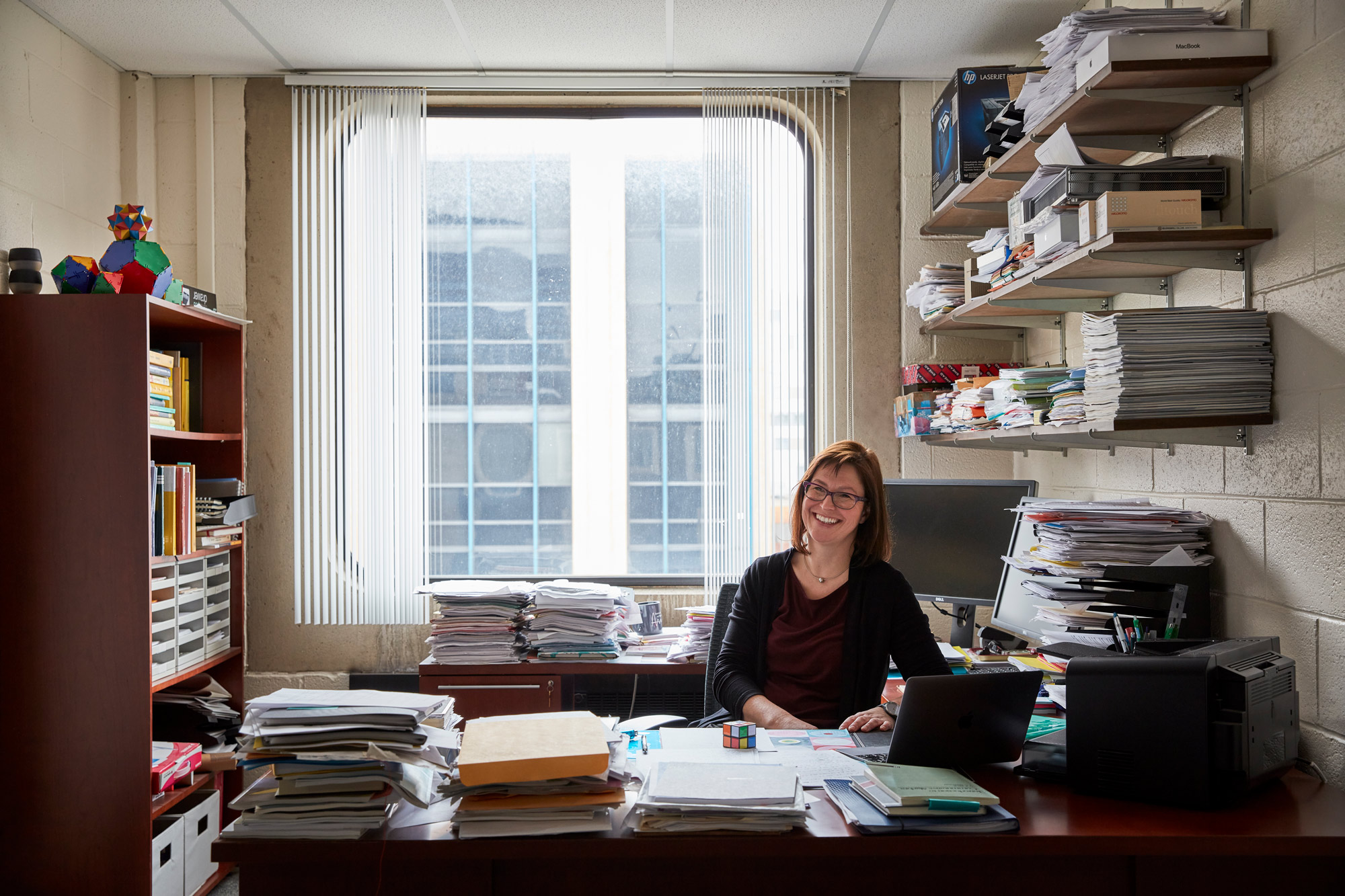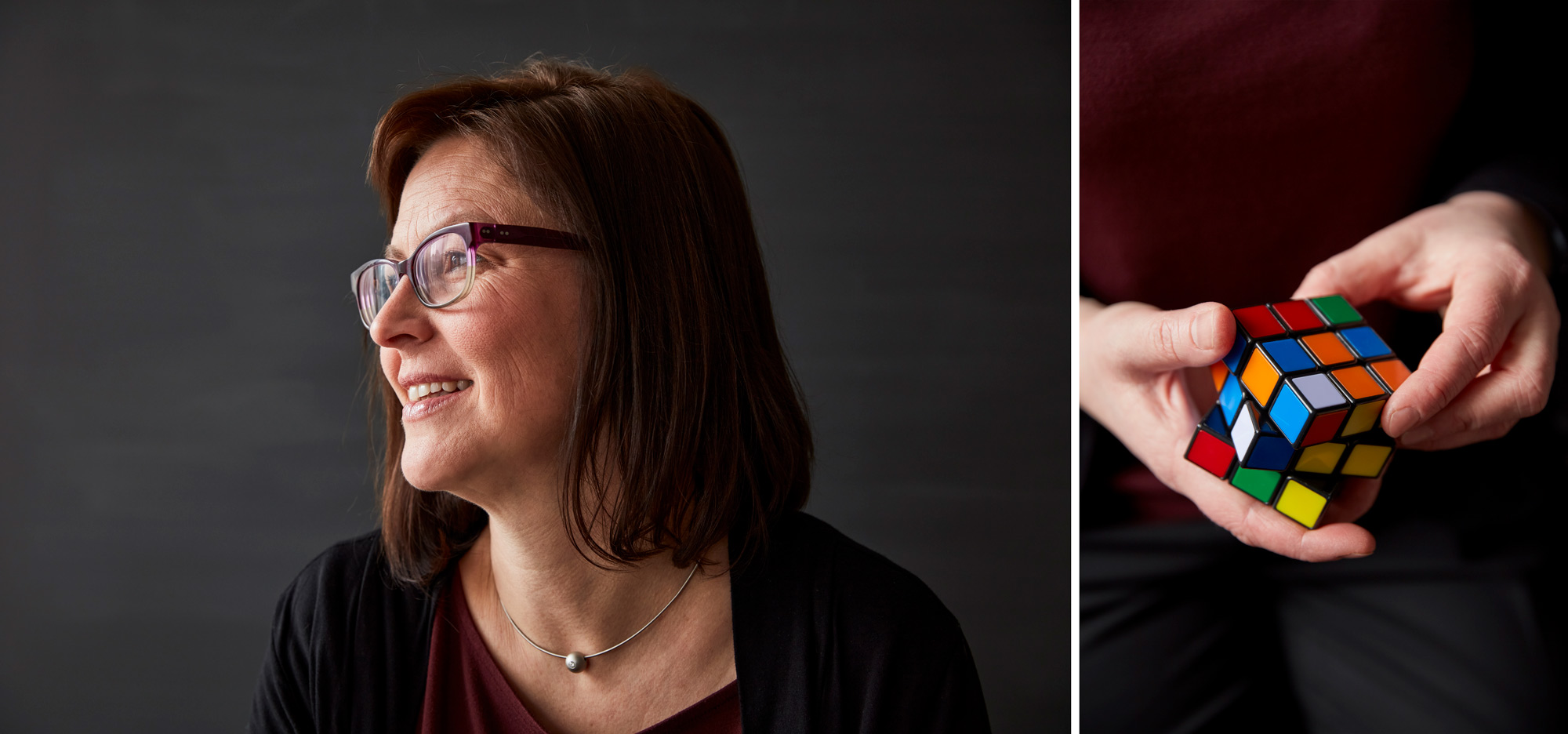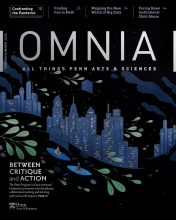The Math Problem
Julia Hartmann is finding solutions, both in math and for mathematicians-to-be.

In front of the sofa in Julia Hartmann’s office, math-related toys—a two-by-two Rubik’s cube and plastic pieces formed into three-dimensional shapes called Platonic solids—cover the table. They’re useful in her teaching, but they serve a different function here. “I’ve noticed that it’s easier for students to talk if they have something to do with their hands,” says the professor of mathematics. In a field that is often negatively perceived, Hartmann spends a lot of time thinking about how to ease the way for students at all levels.
- 75 percent of middle- and high-school students have heard an adult speak negatively about math. (2018 Texas Instruments survey)
“It’s probably the only subject where you could say, ‘Oh, I’ve always hated math,’ and expect that this will be personable rather than look bad,” she says. “If you said you’ve always hated music, people would look at you and say, ‘Oh, my God.’”
Hartmann is a Simons Foundation fellow who explores algebra and arithmetic geometry, the latter a relatively young field that applies techniques from algebraic geometry to solve problems in number theory. One example is Fermat’s Last Theorem, a number theory problem that was proposed in 1637 and proved in 1994 using techniques from geometry.
Before she came to Penn, Hartmann headed a research group at RWTH Aachen University and was a von Neumann Fellow at the Institute for Advanced Study. Collaborating with David Harbater, Christopher H. Browne Distinguished Professor of Mathematics, she developed the method of field patching, which has expanded the ways mathematicians can analyze the relationships between local and global behaviors of mathematical objects.
Growing up in Germany, Hartmann found her way to mathematics through a mandatory competition in middle school. She began getting invited to other math competitions, and near the beginning of high school, she was accepted into a three-week summer academy. Suddenly she was surrounded by other young people who were also interested in math. “It was a really fantastic experience to be able to share my thoughts with them, and be challenged by the problems they were giving us,” she says. “It was tough, but it was really, really interesting.
“I think the mandatory competition is a great idea because if I had to sign up for these things voluntarily, I don’t think I would have necessarily done that,” says Hartmann, who wants all students to have the opportunity to meet math and find out if they like it.
In the spring of 2017, to learn more about when negative impressions of math begin, Hartmann organized a math circle at the Penn Children’s Center, a child-care center run by the University. She found that the three- to five-year-olds she worked with didn’t see math as something intimidating or boring.
Hartmann didn’t teach them math as they would in school. Instead, she gave the children puzzles to solve—which she says is more like what mathematicians themselves do most of the time—using hands-on props. One of the activities had the children represent binary code. In another, they were able to figure out how to securely transmit the key to a cryptosystem.
“They really liked it,” she says. “Some of the kids I’d still see when I would take my son to school, and they’d say, ‘When are we doing the math again?’”
- 46 percent of students said that they liked or loved math compared to 24 percent who said they hated or disliked it. (2018 Texas Instruments survey)
To reach older kids, Hartmann gives talks for career days. “You can show them interesting and fun things they wouldn’t otherwise see in school, that might make them more interested in math,” she says. “Or at least less averse to math.” She also contributed to a German book, Facettenreiche Mathematik, which describes math research so that a high school student or a teacher could understand it.
While fundamental research in math often doesn’t have immediate implications, it can have an impact years later.
When she teaches Ideas in Math to Penn students who range from curious first-years to reluctant seniors, she includes topics like cryptography that have applications in the world, but also abstract, interesting thought experiments. She often hears from former students that they’re still thinking of concepts they discussed. “It’s actually not that difficult to interest people in those subjects, but mathematicians don’t always try,” she says.
Mathematicians are realizing they need to do more outreach—not only for the future of their field, but because the National Science Foundation (NSF) now emphasizes a broader impact as part of funding proposals. These are ways of making math more available and accessible, and can range from public events to radio pieces to writing for a general audience.
“You can’t just say, oh, the world doesn’t understand what I’m doing,” says Hartmann. “You might not be able to explain exactly what you’re working on, but you can still convey some ideas or just try to get some people interested in the subject in general.”
- 68 percent of students said that they would like math more if they understood better how it applied to their future. (2018 Texas Instruments survey)
Whether it’s because of its bad reputation or a lack of comprehension, it can be difficult to realize how much math underlies our lives, from drawing congressional districts to the coding theory used for data transmission and phone calls. While fundamental research in math often doesn’t have immediate implications, it can have an impact years later. One example is the work of Eugenio Calabi, Thomas A. Scott Professor of Mathematics Emeritus, in the 1950s to find a bridge between differential and algebraic geometry. This led to Calabi-Yau manifolds, which have been vital to string theory and mirror symmetry.
- Overall employment of mathematicians and statisticians is projected to grow 30 percent from 2018 to 2028. (2019 report, Bureau of Labor Statistics)
Beyond the research and applications, Hartmann wants people to understand the value of how mathematicians think, saying, “Just the approach that mathematicians have and the way they view the world or the things they study are useful for a lot of people.” She sees consulting companies trying to recruit math majors because they can be put into a completely new situation and understand the framework of what’s going on, analyze things, and propose a solution.
“I believe this way of thinking is something a lot of people can do,” Hartmann says. “But this is not what most people think of when they hear mathematics. They think of numbers and calculations. Tedious calculations. But it’s really something that people can find beautiful if they are exposed to it.”
- Women were 41 percent of undergraduate math majors but only 28 percent of new Ph.D.s. (2015 Annual Survey of the Mathematical Sciences in the U.S.)
Beyond its PR problem, a career in math may present special obstacles to women and underrepresented minorities. Hartmann, the graduate chair of mathematics at Penn, is working to address what has been called the “leaky pipeline” in the U.S., where a disproportionate number of women who study math as undergraduates don’t continue as graduate students. Another group then doesn’t complete graduate school. She dealt with some of the reasons why as a student herself—teachers who assumed she wanted to teach high school rather than be a researcher, and professors who felt it would be a waste of time to teach women because they would get married, have children, and leave their careers. (Note: Hartmann has a marriage, a child, and a career.)
Academic careers involve a lot of traveling, a lot of waiting before you can settle down, a lot of uncertainty. “I have seen people drop out of grad school because they wanted to be near the person they wanted to live with,” she says. “I’m not sure that everybody regrets these choices or that it’s necessarily bad, but I think in a lot of cases, there are things that could be done to help people make choices more freely. Expose young girls to more mathematics, but also be more supportive later on.”
Hartmann is involved with Penn’s Women in Math group, which serves all levels from undergraduates to faculty, and she is the faculty sponsor for the Penn chapter of the Association for Women in Mathematics, for undergraduates. The groups work to create a more inclusive atmosphere for women and encourage them to pursue math as a career. They sponsor events that foster a community, from regular study groups to a showing of Hidden Figures. The Women in Math group is continuing to meet virtually during the coronavirus emergency, and Hartmann is happy to see students organizing additional Zoom calls to keep up the sense of community.
In September 2019, the one-day event Math Women with a Mission, sponsored by the Penn Fund to Encourage Women, showcased how female researchers use math to change society, and speakers from other universities and the National Security Agency have also come to campus. Female undergraduate students who were thinking about applying to graduate school came to Penn from all over the U.S. last fall for WOMAN UP! (Workshop on Math Advice and Networking at UPenn), co-organized by Hartmann and Mona Merling, Assistant Professor of Mathematics. Programs like this are sought out by female students, says Hartmann.
In the summer of 2019, Hartmann worked with Renee Bell, Hans Rademacher Instructor of Mathematics, and postdoc Valentijn Karemaker, along with female mathematicians from Georgia Tech and MIT, to organize an American Mathematical Society conference in Rhode Island focusing on her own field, arithmetic geometry. The conference, “Explicit Methods in Arithmetic Geometry in Characteristic p,” was designed to help early-career researchers collaborate and gain skills, as well as advance research.
Female undergraduate students who were thinking about applying to graduate school came to Penn from all over the U.S. last fall for WOMAN UP!
Arithmetic geometry uses geometric approaches to look at problems in number theory. An example is local-global principles. In geometry, when you can determine a characteristic by looking everywhere locally—like examining the outside of a ball—it satisfies the local-global principle. Hartmann applies that thinking to algebra, finding truths about numbers by looking at one prime number at a time.
Get More Math-y
“I think a lot of people would be more interested if they could see math as a kind of tool to see more structure and organization in the world,” says Hartmann. “A lot of people are already doing this, maybe without knowing it. Then the question is, how can you learn to think more that way?”
Some suggestions:
- Look for math circles and fun activities. You can follow the National Math Festival page on Facebook to learn more about the Washington, D.C.-based event and find puzzles and videos.
- Read books like Jordan Ellenberg’s How Not to Be Wrong, which Hartmann calls “a really good start for people to learn what math really is and how to think about it, and I think it’s fun to read. It’s not a textbook.”
- Check out the Global Math Project’s RAMD (Random Acts of Math Delight) section. These are designed for classrooms but include things like “The Math of Twinkle, Twinkle, Little Star” and how to calculate pi with real pies.
All of Hartmann’s research is connected by the study of symmetries—actions of groups on algebraic objects. Solutions to equations often form symmetric patterns, she says, so looking at symmetries provides a path to get from one solution to another solution.
She is still working with Harbater, and with a number of other researchers at and beyond Penn. Hartmann says that math, which has traditionally been a very solitary enterprise, is becoming more collaborative. “You’re basically sitting in a room with some people you like and you’re bouncing ideas off each other and you’re finding interesting things and it’s really exciting,” she says. “It opens it up more. It makes it easier for people to get started, and it also makes it more interesting.”
Thanks to a Focused Research Grant from the NSF, Hartmann has several papers with six authors, which is still unusual in pure mathematics. “The most interesting new math comes from the fact that people from different areas collaborate,” she says.
- Of 1,957 new doctoral recipients in math in 2017, 212 were from underrepresented minority groups. (Annual Survey of the Mathematical Sciences)
A broader range of viewpoints is part of the reason Hartmann wants to widen her focus to minorities who are underrepresented in mathematics. “We’re researchers and we’re teachers,” she says. “As researchers, we want the sharpest minds, not to restrict our search to certain groups of society. As teachers, we’re aiming to teach a diverse group of students, and therefore, in order to make them feel at home and be able to understand their issues and their problems, we need a diverse community of teachers.”
Julia Hartmann loves her job: the research, the teaching, the traveling, the flexibility. “I have collaborators all over the world, and mathematics is really the same wherever you go. You can talk to almost anyone. And I can do math wherever and whenever I want. I could sit in a café and have a good idea and all I need is a pen and a napkin or something.”
She would like others to have some of the same enjoyment she gets out of math. “The only thing I really want to achieve is to have a few more people out there in the next generation that don’t say, ‘Oh, I’ve always hated math.’”








